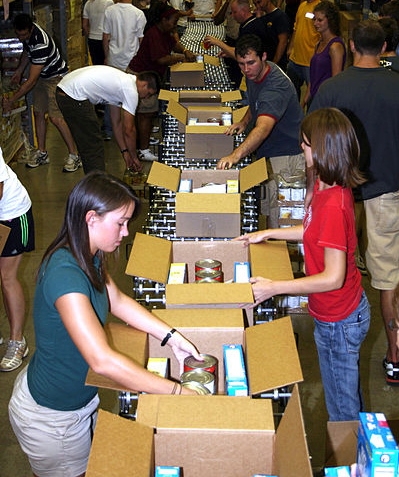
1. Ask what is needed before you give.
Sometimes what we want to give—holiday foods, homemade jam, or cake mixes---may not be what is needed. Check the website of your local food bank or call to see what foods they currently need. Generally, the most needed items are:
• Peanut butter
• Canned meats such as tuna or chicken
• Cereal
• Canned and dried fruit
• Canned vegetables
• Macaroni and cheese
• Canned soup.
2. Choose a more nutritious form of the food you want to give.
?For example, select:
• Fruit canned in its own juice rather than syrup
• Vegetables canned without added salt
• Cereals that are high in fiber and don't have much added sugar
• Whole grains such as brown rice, whole wheat pasta, and quinoa
• Low sodium soups and low-sodium versions of other products such as pasta sauce
• Lean protein, such as beans and canned tuna.
3. Check the use-by or expiration date on canned or packaged food items.
If donating food items from your own pantry, check the freshness date. Most food banks will not give out food that is past the use-by or expiration date printed on the container. (Use-by and expiration dates refer to the quality of the food, not the safety.)
4. Avoid foods in glass containers or damaged packaging.?
Some food banks don't accept food in glass containers---even baby food or infant formula---because they chip and break easily. Inspect the packaging of an item. Avoid dented or bulging cans. Food banks won't accept damaged or open paper or plastic containers. Only donate commercially prepared foods. Food banks cannot take home preserved foods.
5. Give with the food bank clientele in mind. ?
Are the clientele homeless? If so, they probably don't have access to storage or refrigeration. Dr. Lucia Kaiser, Nutrition Specialist at the University of California Cooperative Extension, suggests giving easy-to-prepare and ready-to-eat foods such as:
• Pop-top cans of stew, chili, and soup
• Shelf-stable milk and cheese
• 100% fruit juices in single serving boxes
• Convenience foods like granola bars, packaged crackers (low fat), beef jerky, and single-serving packages of nuts.
Programs for children may want single serving sizes of foods, such as;
¥ 100% fruit rolls
¥ Raisins
¥ Graham crackers
¥ Unsweetened applesauce
¥ Fruit cups
¥ Low-sugar cereal bowls
¥ Pretzels
Ideas to Help You Plan a Healthy Food Drive?
Request donations by meal (breakfast, lunch, or dinner), by food group (fruits and vegetables, dairy, protein, etc.), or by recipes. Another option is a SuperFood Drive where participants donate items on a list of nutrient-dense foods that you provide. Or, help potential donors by giving them Dorothy Smith's food bank gift list.
Here's to healthy living and giving during the holiday season!